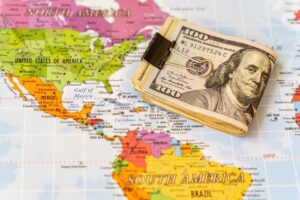Tariffs: A Trade Tool That’s Losing Its Mojo
The author of this piece, Wendy Cutler, is a featured speaker at the upcoming WITA Academy Mini Virtual Intensive Trade Seminar on tariffs. Find more information here and below.
The recent victory of President-elect Trump has once again brought the tariff debate to front and center. Trump continues to talk about tariffs as the “go-to” tool for balancing our trading relationships, halting the “cheating” by our trading partners, bringing U.S. manufacturing home, and raising revenue to support other tax cuts.
Of the wide array of tariff proposals floated by Trump, his initiative to impose at least an additional 60 percentage points of duties on imports from China is one of the most severe. Even before recent Biden selective tariff hikes, the U.S. average tariff rate with China was close to 20 percent, having increased significantly during his first term.
An additional 60 percentage point increase would bring many of these rates to the “prohibitive zone,” essentially stopping trade. Some speculate this may be a way for Trump to gain leverage to negotiate a new bilateral trade deal with China. But, in many ways this time around it seems to be more about disentangling our two economies rather than getting to a deal.
What’s lost in the debate, is the effectiveness of such tariff increases, particularly at a time when Chinese investments in third countries are growing by leaps and bounds. For example, Chinese investment in ASEAN countries has surged from less than $4 billion in 2010 to $17 billion in 2023.
As Chinese companies set up more factories abroad in the automotive, clean energy and electronics sectors, the goods produced by these firms in third countries would not be subject to Trump’s 60 percentage point tariff increase. Rather, these goods under current international trade rules would receive the tariff treatment of the country hosting the investment and exporting the good to the U.S., provided specific product origin requirements are met.
An important consideration driving Chinese companies to move their operations out of China is the avoidance of U.S. tariffs. But, other forces are at play, including closer proximity to consumers in third countries and pressures from weak domestic demand, as well as strengthening economic ties with partners around the world. The latter is particularly critical as we see more of a bifurcation of the global economy along China/U.S. lines.
U.S. policymakers have taken certain steps to address concerns about this trend, particularly aimed at those Chinese investments intended to produce goods for export to the United States. After a respite of two years, the U.S. is now applying duties on solar imports from four Southeast Asian countries where Chinese companies have invested largely for tariff circumvention reasons.
The U.S. and Mexico have recently strengthened the United States-Mexico-Canada agreement rule of origin requirement for Mexican steel exports to the U.S. to further curtail Chinese exports from our southern neighbor. With respect to vehicles, the U.S. is finalizing a “connected car” rule based on national security concerns which would go a long way in banning the import of Chinese electric vehicles into the U.S., regardless of where they are produced.
Each of these efforts is notable, but all are rather ad-hoc and reactive in nature. The U.S. should develop a more strategic response, making it clear that Washington’s focus is not on all Chinese imports from third countries, but rather on those goods that are either unfairly traded, circumvent U.S. laws and regulations or create national security concerns.
Read the Full Opinion Here
11/21/2024 | Wendy Cutler | The Hill
Expect Trump’s Demands, Not Rules, to Govern US Trade Policy
President-elect Donald Trump has introduced a momentous change to international trade relations. For the last 80 years, negotiations were about lowering trade barriers and improving the rules governing trade. Now, for the United States, it is about the demand of the day—halt fentanyl shipments and the movement of migrants (directed at Mexico and Canada) and drugs (China) or keep using the dollar as the currency for international exchange (emerging countries, “BRICS”). It does no good for the other countries to cite prior trade agreements with the United States, not even Trump’s updated North American Free Trade Agreement (USMCA). The applicable standard in these negotiations is not what was previously agreed between nations; it is a world governed by power politics. As opposed to the rule of law, the operative principle for countries engaged in trade with the United States is (using a French phrase) sauve qui peut, or in plain English, “each who can, save yourself.” This is the advice the captain of a sinking ship might give to remaining passengers when there are no more lifeboats.
Under the rules of the trading system the United States created in 1947 in the post-World War II world, every country received MFN (“most favored nation” or nondiscriminatory) treatment if it accorded that treatment to the trade of others. One hundred sixty-six nations joined the World Trade Organization (WTO) and pledged not to use tariffs as a weapon but to contractually bind them at agreed (mostly low) levels, and not to discriminate among suppliers, unless it is to eliminate tariffs altogether and to aim for free trade.
The idea was, the more trade was unrestricted, under a policy of (another bit of French here) “laissez-faire,” or “hands-off” to the extent possible, all would benefit in a robustly growing world economy. And, overall, this is what happened (albeit not for all participants, a failing for which the United States and the WTO are paying a price). The assumption (and policy) that more open trade would be beneficial began to evaporate when the Congress failed to approve the Trans-Pacific Partnership under President Obama and Trump cancelled US participation in it as soon as he took office. Then the world got a taste of Trump tariffs—against steel and aluminum and on products from China. The Biden administration kept the Trump tariffs largely in place and added some of its own on China trade, particularly for semiconductors, batteries, solar panels, and a relatively short list of other goods.
The 17th century French minister of state, Jean-Baptiste Colbert, set the stage for “Make America Great Again” (MAGA) trade policy when he conducted France’s trade based on mercantilism: Imports were to be discouraged and domestic manufacturing supported while seeking to eliminate large trade deficits. Friend-shoring was not mentioned by Colbert from what we know, just as it is clearly not embraced by the incoming US administration.
The United States is not the first country in modern times to deploy power as a basis for trade relations, just the first to do so openly. China has practiced trade coercion repeatedly—against Korea for deploying Terminal High Altitude Area Defense (THAAD) missiles, Australia for questioning the source of COVID-19 in Wuhan, and Lithuania for welcoming a Taiwan office, as well as by bringing retaliatory cases before the WTO when WTO trade remedies have been invoked against it. China’s “wolf-warrior” approach to diplomacy fits best with an autocratic form of government organization. A strong man at the helm has been spoken of admiringly by the US president-elect. While the United States has employed economic sanctions on numerous occasions, it has not done so for commercial gain. With his threats, Trump is now obliterating the boundary the United States has maintained between commercial affairs and sanctions for foreign policy objectives.
Read the Full Blog Here
12/03/2024 | Alan Wm. Wolff | Peterson Institute for International Economics
What Would Trump’s Tariff Proposals Mean for U.S. Trade with Latin America?
“To me, the most beautiful word in the dictionary is tariff,” said Donald Trump during an interview at the Economic Club of Chicago last October.
Throughout his successful 2024 presidential campaign, Trump frequently spoke of tariffs—taxes on imported goods paid for by the importer—at rallies and in interviews. Tariffs, according to the 2024 Republican platform, are key to a vision that ensures global trade benefits Americans.
While the president-elect has proposed universal 10 to 20 percent tariffs on all goods imported to the United States, he threatened the United States’ top trade partners—Mexico, Canada, and China—with higher rates. On November 25, Trump announced that he will impose a 25 percent tariff on all goods from Canada and Mexico through an executive order on his first day in office. “This tariff will remain in effect until such time as drugs, in particular fentanyl, and all illegal aliens stop this invasion of our country,” he wrote on his Truth Social account. He also announced an additional 10 percent tariff on all goods from China, citing the same reason: fentanyl entering the United States. On November 30, Trump threatened to impose a 100 percent tariff on goods from countries that make up the BRICS, which includes Brazil, over the bloc’s proposal to create its own currency.
Trump’s proposed tariffs could mean big changes for industries in and outside the United States, North America’s supply chains, and U.S. trade partners in Latin America. The United States has six free trade agreements in effect with 11 Latin American countries. The region is home to some of the country’s largest sources of imports, including its biggest trade partner, Mexico. These potential trade barriers could become a sticking point when it comes to the scheduled 2026 review of the United States-Mexico-Canada Agreement (USMCA).
Read the Full Article Here
12/03/2024 | Gladys Gerbaud | Americas Society/Council of the Americas
How Maritime Trade has Become a Tool of Diplomacy and Deterrence
Following is an excerpt. The full piece is linked below, and here.
Trade, once a symbol of peaceful exchange and shared prosperity, is increasingly wielded as an instrument of power in the geopolitical arena, blurring the lines between commerce and conflict. In the maritime domain, where over 90 per cent of global trade flows, control over critical sea lanes and chokepoints has become synonymous with strategic dominance. Nations recognise that the ability to secure or disrupt trade routes can shape economic fortunes and influence geopolitical outcomes. This realization has transformed trade into an article of war, where navies, equipped with both traditional and cutting-edge unmanned systems, play a decisive role in defending economic lifelines while projecting influence.
The Indian Ocean Region (IOR) exemplifies this duality, serving as a theater where the competition for resources and influence meets the promise of collaborative security. The rise of unmanned systems, from autonomous surveillance drones to robotic underwater vehicles, is reshaping how navies address threats and enforce maritime order. These technologies, combined with cooperative frameworks like the Quad and IONS, empower nations to counter asymmetric challenges such as piracy, smuggling, and state-sponsored disruptions. By seamlessly integrating advanced systems with traditional assets, navies are not only safeguarding commerce but also ensuring that the balance of power remains equitable in a region critical to global stability.
In this era of contested waters and strategic competition, the essence of maritime trade as a tool of diplomacy and deterrence is clear. Navies are no longer just the custodians of commerce; they are architects of a maritime order that underpins global peace and prosperity. The convergence of innovation, strategy, and international collaboration offers a blueprint for navigating these complex waters. As the great naval theorist Sir Julian Corbett observed, “The object of naval warfare is to secure command of the sea.” In the IOR, achieving this command increasingly requires a blend of innovation, cooperation, and strategic foresight.
As the Indian Ocean grows in strategic importance, India’s vision of a secure, inclusive, and technologically empowered maritime domain could serve as a model for balancing economic ambition with strategic responsibility, ensuring that trade continues to be a bridge of cooperation rather than a battleground of conflict.
Read the Full Opinion Here
12/04/2024 | Commander Rahul Verma (Retd) | Firstpost





